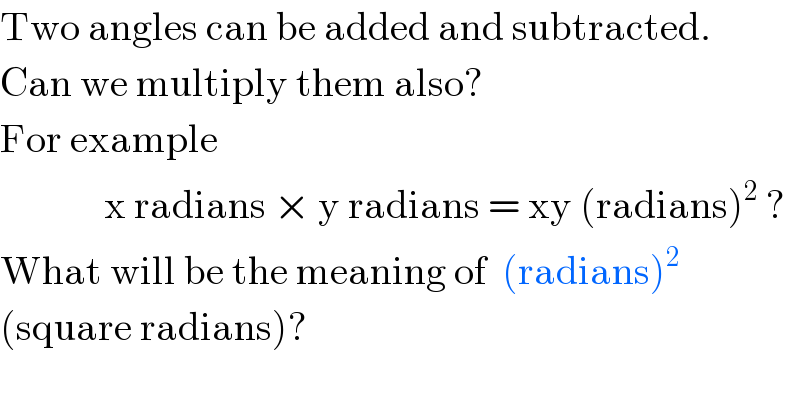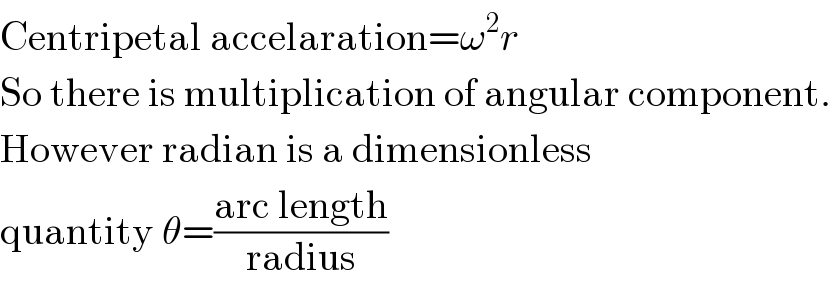Question Number 5718 by Rasheed Soomro last updated on 25/May/16

$$\mathrm{Two}\:\mathrm{angles}\:\mathrm{can}\:\mathrm{be}\:\mathrm{added}\:\mathrm{and}\:\mathrm{subtracted}. \\ $$$$\mathrm{Can}\:\mathrm{we}\:\mathrm{multiply}\:\mathrm{them}\:\mathrm{also}? \\ $$$$\mathrm{For}\:\mathrm{example}\: \\ $$$$\:\:\:\:\:\:\:\:\:\:\:\:\:\mathrm{x}\:\mathrm{radians}\:×\:\mathrm{y}\:\mathrm{radians}\:=\:\mathrm{xy}\:\left(\mathrm{radians}\right)^{\mathrm{2}} \:? \\ $$$$\mathrm{What}\:\mathrm{will}\:\mathrm{be}\:\mathrm{the}\:\mathrm{meaning}\:\mathrm{of}\:\:\left(\mathrm{radians}\right)^{\mathrm{2}} \\ $$$$\left(\mathrm{square}\:\mathrm{radians}\right)? \\ $$
Commented by FilupSmith last updated on 25/May/16
![θ = angle in radians θ∈(0, 2π] ∴ 0≤θ<2π if θ≥2π:θ=2π+k then θ=k (in most situations) although I am unsure about your question, I would assume that you can multiply. e.g. θ=ab (a and b and angles) if ab=2π+k, k≥0 ab=k ∴θ=k sorry about the bad answer.](https://www.tinkutara.com/question/Q5725.png)
$$\theta\:=\:\mathrm{angle}\:\mathrm{in}\:\mathrm{radians} \\ $$$$\theta\in\left(\mathrm{0},\:\mathrm{2}\pi\right] \\ $$$$\therefore\:\mathrm{0}\leqslant\theta<\mathrm{2}\pi \\ $$$$ \\ $$$$\mathrm{if}\:\theta\geqslant\mathrm{2}\pi:\theta=\mathrm{2}\pi+{k} \\ $$$$\mathrm{then}\:\theta={k}\:\:\:\:\:\left(\mathrm{in}\:\mathrm{most}\:\mathrm{situations}\right) \\ $$$$ \\ $$$$\mathrm{although}\:\mathrm{I}\:\mathrm{am}\:\mathrm{unsure}\:\mathrm{about}\:\mathrm{your}\:\mathrm{question}, \\ $$$$\mathrm{I}\:\mathrm{would}\:\mathrm{assume}\:\mathrm{that}\:\mathrm{you}\:\mathrm{can}\:\mathrm{multiply}. \\ $$$$ \\ $$$$\mathrm{e}.\mathrm{g}. \\ $$$$\theta={ab}\:\:\:\:\:\left({a}\:\mathrm{and}\:{b}\:\mathrm{and}\:\mathrm{angles}\right) \\ $$$$\mathrm{if}\:{ab}=\mathrm{2}\pi+{k},\:\:\:\:{k}\geqslant\mathrm{0} \\ $$$${ab}={k} \\ $$$$\therefore\theta={k} \\ $$$$ \\ $$$$\mathrm{sorry}\:\mathrm{about}\:\mathrm{the}\:\mathrm{bad}\:\mathrm{answer}.\: \\ $$
Commented by prakash jain last updated on 25/May/16

$$\mathrm{Centripetal}\:\mathrm{accelaration}=\omega^{\mathrm{2}} {r} \\ $$$$\mathrm{So}\:\mathrm{there}\:\mathrm{is}\:\mathrm{multiplication}\:\mathrm{of}\:\mathrm{angular}\:\mathrm{component}. \\ $$$$\mathrm{However}\:\mathrm{radian}\:\mathrm{is}\:\mathrm{a}\:\mathrm{dimensionless} \\ $$$$\mathrm{quantity}\:\theta=\frac{\mathrm{arc}\:\mathrm{length}}{\mathrm{radius}} \\ $$
